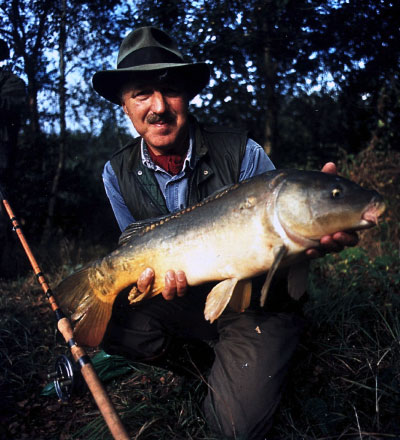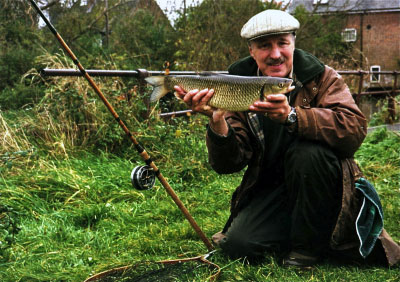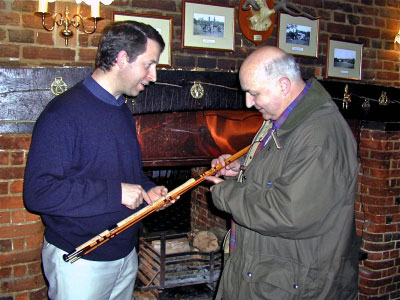For those poor unfortunates born in the this soulless new Carboniferous period, I should explain that the Allcocks Wallis Wizard was a magical creature of the 1930’s. An eleven foot all-round fishing rod, made in three pieces. The butt was of whole tonkin cane, and the middle and top were made from proper split cane. It was, and is, a supremely capable thing that has an innate fish catching inclination. It was Demus Canning who first pointed that out to me, and he was dead right. Luck, or whatever it is that conjures the fish; it comes as standard free extra with a Wizard.
 |
|
“Luck comes as standard free extra with a Wizard.” |
The rod was first made, I believe, around the early 1930’s, and it was named after the famous F.W.K.Wallis. Wallis was the Dick Walker of his Day, and the then holder of the barbel record. There must be a story in there somewhere because early Wizards had an Allcocks gold oval above the handle, and a further small spiral printed transfer saying simply, Wallis Wizard. I’m not sure whether this actually had the approval of the illustrious Mr. Wallis, because it wasn’t long before the Wallis name was dropped, and the name Wizard was incorporated into the gold oval. At about the same time, Hardys started to make their beautiful Wallis Avon rod: a slightly lighter version of the Allcocks Wizard. If we apply a few totally unproven leaps of faith, then it sounds as though Hardys might have objected to their star angler’s name being used on rivals’ rods.
It is my belief that the early Wizards were the best. It helps to know how to recognise these early gems. They can quickly be recognised by either that small spiral Wallis Wizard label, or the slightly later, famous Allcocks gold oval label with the simple Wizard name in the lower one third. Early Super Wizards were also labelled simply Wizard. Early Wizards were often painted with a sort of green stain, and having been well protected under all that paint, they’re often in new condition when stripped. Until the late 1940’s all Wizards were fitted with real agate in German silver butt and tip rings, and high quality spigot ferrules. In the early 1950’s the gold oval remained, but high quality non spigot ferrules were fitted. Later Wizards seem to have slightly smaller section whole cane butts, and the late rectangular Allcocks label is used.
 |
|
“John proves he does catch the odd fish – a nice chub on a Wizard” |
Although the Wizard had the same general look about it throughout its long production life, the action varied considerably. Understandably, the natural whole cane butt sections vary in diameter, but more surprisingly, there are also considerable differences between the split cane sections from period to period. You would think that Allcocks would have made all their Wizards to set sizes, but they certainly didn’t. Armed with a dial vernier gauge, I have found huge (by rod-making standards) differences between the blanks. The rods therefore vary considerably in character, from an easy though action, to quite tippy. A small butt with a heavy tip produces quite a floppy feel: a heavy butt (some are thicker than Avocets) with a steep taper middle, and a light tip, produces a stiffer, tippier feel. They’re all lovely, but some are lovelier than others.
A few late Wizards have an improved 20″ handle length, (too little, too late) and bored shive corks rather than original sheet-cork covered pine version. Many late Allcocks rods, including Wizards, were fitted with tapered but unserrated ferrules. They are strong, but because of the sudden transition to the cane surface, they tend to produce cracking of the varnish at that interface. There are two remedies: the ferrules can be replaced, or serrations carefully cut into the ferrules. This can only be done properly and safely with the ferrules off the rod.
The standard rod has (two) too few rings, but this is easily remedied. The Super Wizard has agate lined rings throughout (again too few). These rings look very up-market, but they are also very heavy, and quite unsuitable for the light tip section. I always replace them all with standard chrome-plated stainless steel, high or low rings, and this makes the rod feel far less floppy.
My opinions about the standard Wizard handle
are well known. Whilst I am aware that this may be seen by rod historians as a Barbaric heresy, I have to say that I believe the Wizard (and Wizard style rods of all makes) is profoundly improved by replacing the standard 17″ handle with a new 21″ version. B. James knew this when they brought out their lovely Avocet model: effectively a modified Wizard taper, with a long (24″) handle.
Using the basic Allcocks’ Wizard as a basis for meddling, all sorts of wonderful rods can emerge. Beyond the top of the handle the rod tapers should be considered sacrosanct, but by replacing the decidedly stiff short handle with an extension of whole cane a much more lithe rod is produced. A longer stiff handle makes the whole rod quite beefy.
Early in the day, Allcocks recognised the new convenience of fixed spool reels, and the Wizard was oft-times illustrated with a ‘threadline’ reel attached. Despite this manufacturer-approved status, I find it somehow discordant to attach anything other than a centre-pin to a Wizard. My favourite is a 3.5″ pre-war Aerial, which fits just so for size and appearance. Given a following wind, and using the particularly appropriate Wallis cast, I can cast a three swan-shot rig thirty yards with this outfit. The rod is equally happy as a light leger rod, with a natural affinity for chub under trees. Wizard aficionados sometimes have a Wizard especially equipped with bells life, or full open bridge rings, which are more suitable for legering, because they put less twisting moment into the rod.
The ULTIMATE Wizard, I mean, the one that all collectors would kill for, is the Black Label Wizard. I have seen only one, and that was forty years ago, in a shop window in Staplehurst, Kent. The BLW was made (according to Tony Croft, who was a rodmaker at Allcocks for much of his working life) in the late 1930’s. The one I saw had a long whole cork handle, with brass fittings, and a black Allcocks oval, with gold lettering. It was gorgeous. One enthusiast told me that only a few were ever made, and that the black label was in honour of a dead Allcock. It’s a good story, whatever the truth of it. One or two BLW reproductions have been made over the years, and they are VERY desirable.
 |
|
“The ULTIMATE Wizard is the Black Label Wizard.” |
It’s perhaps worth telling the story of the last Wizard I bought. I was in a Masonic hall on the south coast – I should add that I was not resplendently dressed in blue apron, glittering with symbolic Masonic motifs, but rather, scanning the dowdy stands of a weekend antiques fair. A rod, draped over the top of a stall caught my eye. Hey ho – a Wizard. ‘How much for that old rod?,’ I asked. ‘Antique that,’ said the greasy oik running the stall, ‘four hundred nicker.’ The greedy blighter. This was obviously going to be a battle of wits. Having run this race on more than one occasion I turned not a hair. ‘I tell you what, I said, if it’s still there at the end of the day, I’ll give you £10.’ ‘Gowan giss fifty,’ said the other. We settled for £20, which was 10% of its real value. Served him right; the profiteering little toe-rag.
If you fancy a Wizard, you shouldn’t hold your breath for a similar bargain. The going price for an unrestored Wizard that is still straight, is about £200, perhaps £250 for a good 1930’s version. A professionally restored Wizard will set you back between £300 and £400, and a perfect Black Label reproduction perhaps £600. If an original oval Black Label turns up you’ll have to fight me for it, whatever the price. Clearly the word has got out, and inflation has come to the world of traditionalist angling. It’s become a bit of a problem for poor enthusiasts. There again, seen against the price ticket of a high tech carbon wand, completely free from love, history, and emotion, the wonders of Wizard ownership would seem to be a bargain. It’s the old story of supply and demand I’m afraid. Top rod restorer Tim Watson tells me he has a waiting list for his state-of-the-art Wizards. I understand he has plans to make reproduction rods, using dimensions taken from the very best pre-war Wizards. If he does get around to making these, it will be marvellous news for traditionalists seeking a state-of-the-art Wizard.
 |
|
Top rod restorer Tim Watson with Peter Wheat. Tim tells me he has a waiting list for his state-of-the-art Wizards. |
I am only too happy to admit that I am an unashamed Wizard enthusiast. I now own six of them, each with its own character; and at one time or another have owned perhaps twenty others. If an angler had to select just one rod for all coarse fishing purposes, this would be a fine choice. As I said before, in its standard form it is such a capable rod, light enough to be used against roach or dace, yet powerful enough to land chub, tench, or barbel from all but the most unforgiving swims. There was a time when it could be recommended for carp fishing, indeed, the much-loved ‘BB’ used just such a rod, but the size of today’s genetically modified Schwartzeneger carp now render the Wizard quite unsuitable. For crucian carp fishing though, it is the weapon of choice.
My own Wizard moments have included roach to over two pounds, a five pound chub, and a ten pound plus carp. Wizard moments have also included fishless days, when the rod has lived in tune, and in peace, with the dragonflies, the lilly pads, and this happy, expectant angler.
John Olliff-Cooper










